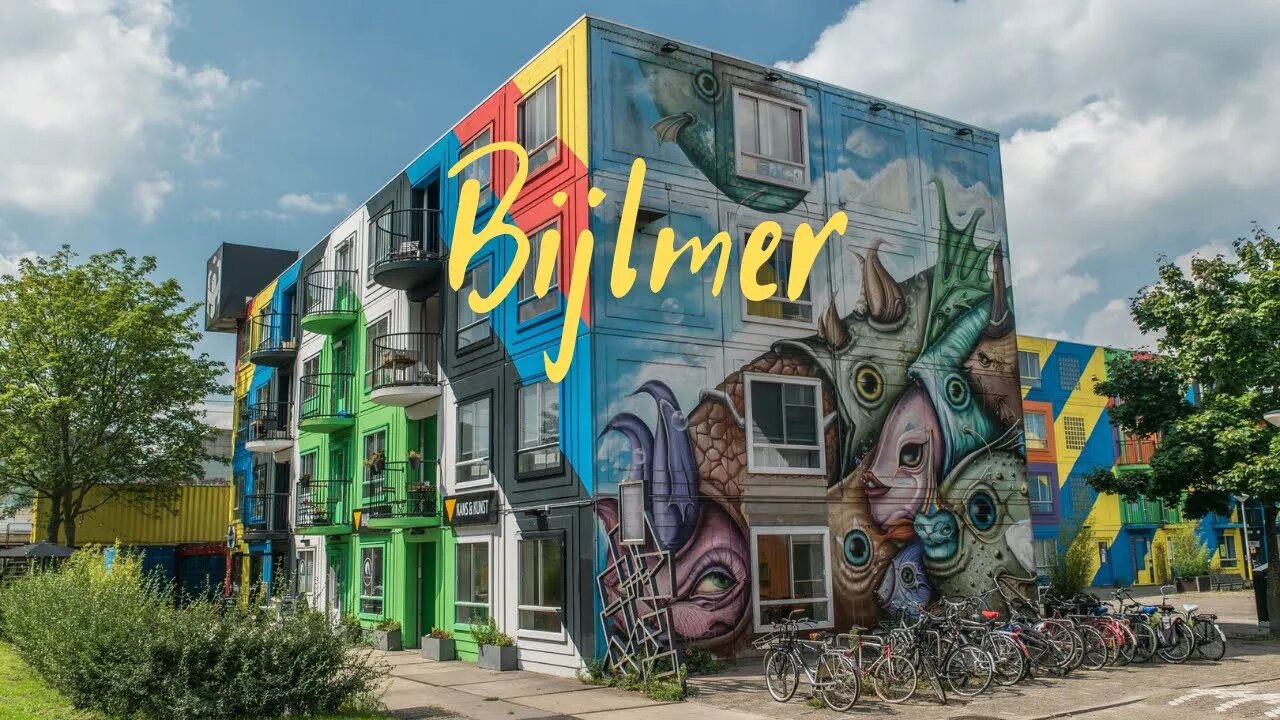Premium Only Content

Bijlmer | Is This Amsterdam's Ghetto? | NL
The Bijlmermeer ([ˈbɛi̯lmərˌmeːr]), or colloquially Bijlmer ([ˈbɛilmər]), is one of the neighbourhoods that form the Amsterdam-Zuidoost borough (Dutch: stadsdeel) of Amsterdam, Netherlands. To many people, the Bijlmer designation is used to refer to Amsterdam Zuidoost as a pars pro toto. The other neighbourhoods in Amsterdam Zuidoost are Gaasperdam, Bullewijk, Venserpolder and Driemond.
The Bijlmermeer neighbourhood, which today houses almost 50,000 people of over 150 nationalities, was designed as a single project as part of a then innovative Modernist approach to urban design. Led by architect Siegfried Nassuth and team, the original neighbourhood was designed as a series of nearly identical high-rise buildings laid out in a hexagonal grid. The goal was to create open spaces for recreation at grade, elevated roads to reduce pollution and traffic from those same recreation areas, and residences climbing upward offering residents views, clean air, and sunlight. The apartments were meant to attract a suburban population, in the manner of condominium housing. The buildings have several features that distinguish them from traditional Dutch high-rise flats, such as tubular walkways connecting the flats and garages. The blocks are separated by large green areas planted with grass and trees. Each flat has its own garages where cars can be parked.
The Bijlmer was designed with two levels of traffic. Cars drive on the top level, the decks of which fly over the lower levels, pedestrian avenues and bicycle paths. This separation of fast and slow moving traffic is conducive to traffic safety. However, in recent years, the roads are once again being put into a single plane, so pedestrians, cycles and cars travel alongside each other. This is a move to lessen the effects of the 'inhuman' scale of some of the Bijlmer's designs and improve safety using direct sightlines.
Because of the Bijlmer's peripheral position relative to the city centre, it was decided that metro lines would be built connecting the Bijlmer with other neighbourhoods. The Oostlijn (east line, comprising two lines, numbered 53 and 54) links the Bijlmer to the Central Station of Amsterdam, while the Ringlijn links it with the port area at Sloterdijk.
Social Issues
Until recently, Bijlmermeer struggled to draw in many middle-class families. Following Suriname's independence in 1975, many of its inhabitants migrated to the Netherlands. The government placed a substantial number of them in affordable social housing in the Bijlmermeer.
The neighbourhood once had a very high crime rate, but this has decreased dramatically in recent years. The number of registered complaints to the police decreased from 20,000 in 1995 (of which 2,000 were robberies) to 8,000 (of which 600 were robberies) in 2005.
The area has always been home to many different nationalities simultaneously. Throughout the years, claims of rising social segregation or ghettoization have been both denied and pre-empted by local government.
Urban renewal
After El Al Flight 1862 crashed into two Bijlmermeer buildings in 1992, an incident known as the Bijlmerramp (Dutch for "Bijlmer Disaster"), it was decided that the neighbourhood needed some further change. In recent years, many of the high rise buildings have been renovated or torn down. More expensive low-rise housing has been built to attract more middle- and upper-income residents. This resulted in significant reduction in crime and a more balanced socio-economic composition, whilst at the same time maintaining the area's ethnic mix. Lately students have discovered the Bijlmer as an affordable place to live compared to the city centre where space is limited and costs of living are high.[2]
Events and sights
Amsterdam Zuidoost is host to Ajax Amsterdam's ArenA football stadium, which hosts football matches and musical concerts, the Pathé ArenA multiplex cinema with 14 screens, the Heineken Music Hall and music and theatres, located in the business park area of Amsterdam Zuidoost, just to the west of the Bijlmer. The recreational strip is called the ArenA Boulevard. The strip mostly hosts concerts, with a very small number of bars and no night clubs. It has not been able to compete with Amsterdam's city centre for the casual Saturday night crowd.
The Bijlmer boasts Amsterdam's biggest shopping centre, the "Amsterdamse Poort", though Amsterdam's city centre remains the largest shopping area. Alongside the shopping centre, the "Anton de Kom plein" (square) is completed, it houses a cultural centre and the borough administrative offices ("stadsdeelkantoor").
In 2012 the entire area from the Ziggo Dome in the west, Villa Arena home furnishings mall, the ArenA Boulevard and stadium, and the Amsterdamse Poort started being marketed as "ArenaPoort".
The annual Kwaku Summer Festival is a six-weekend long multicultural festival during the summer, with Surinamese, Antillean and African food, music and other events.
-
 1:48:41
1:48:41
Right Side Broadcasting Network
5 hours agoLIVE: President Trump at Commander-in-Chief Trophy Presentation to the Navy Midshipmen - 4/15/25
51K4 -
 1:16:30
1:16:30
The HotSeat
2 hours agoJoe Biden Crawls Out of the Basement, Meanwhile AOC Cosplays Kamala
21.7K4 -
 9:25
9:25
Talk Nerdy Sports - The Ultimate Sports Betting Podcast
1 hour ago4/15/25 - Solo Mission: Play-In Carnage & Diamond Sniping
12.8K1 -
 1:11:07
1:11:07
Jeff Ahern
2 hours ago $0.64 earnedTrending Tuesday with Jeff Ahern!
15.9K1 -
![[Ep 650] Left Victimizes Karmelo Anthony | Defund NPR/PBS | Guest Sam Anthony [your]NEWS](https://1a-1791.com/video/fww1/46/s8/1/1/X/o/C/1XoCy.0kob.1-small-Ep-650-Left-Victimizes-Karm.jpg) LIVE
LIVE
The Nunn Report - w/ Dan Nunn
2 hours ago[Ep 650] Left Victimizes Karmelo Anthony | Defund NPR/PBS | Guest Sam Anthony [your]NEWS
173 watching -
 1:23:56
1:23:56
Tommy's Podcast
14 hours agoMMR & Operation Mockingbird | Dr. Robert Malone (TPC #1,727)
28.3K4 -
 1:16:16
1:16:16
Russell Brand
5 hours ago'Neo-Nazi' Satanic Plot To KILL TRUMP! Teen CHARGED With Murdering Parents – SF566
150K64 -
 1:21:03
1:21:03
Sean Unpaved
5 hours agoWNBA's Newest Stars, NFL Trade Rumors, & White House Blunders
58.1K -
 LIVE
LIVE
LFA TV
19 hours agoLFA TV - ALL DAY LIVE STREAM 4/15/25
851 watching -
 1:09:58
1:09:58
The White House
6 hours agoPress Secretary Karoline Leavitt Briefs Members of the Media, Apr. 15, 2025
70.7K34